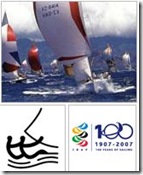Dutch sailing skills
I was watching the women's sailing competition today from the Qingdao Olympic Sailing Center, located on the Yellow Sea about 500 km SE of Beijing. The Sailing Center is built on an old shipyard of the port, close to the business center of the city, and the events take place in Fushan Bay against the backdrop of the skyscrapers.
The women race in 3-person teams in a standardized Yngling keelboat, just over 6 meters long and weighing 645 kg fully crewed.the spinnakers have national flags which makes it easy to spot the teams and mark everyone's progress.
When I tuned in, the 2nd heat racers were crowded around the second mark: it was hard to tell who was ahead as everyone jostled for position and wind.
Usually, sailboat races feel predictable: one-class boats are evenly matched, the wind is pretty consistent across competitors, and, with evenly matched crews, the boat order doesn't change much over the course of a race unless there is an equipment failure or an error. So the team that is ahead usually seems to stay ahead. No sign of the Dutch team, though.
 But, as the boats came out of the last mark, the coverage suddenly shifted to show the Dutch women's team sailing lightly across the finish line. The final statistics show that they were over a minute ahead of all three of the next finishers, who were bunched within 25 seconds of one another. This included the favored British and American teams.
But, as the boats came out of the last mark, the coverage suddenly shifted to show the Dutch women's team sailing lightly across the finish line. The final statistics show that they were over a minute ahead of all three of the next finishers, who were bunched within 25 seconds of one another. This included the favored British and American teams.
The detailed statistics were even more remarkable. On the 'windward-leeward' course (the race was limited to going back and forth between the first and fourth of the four course markers), the Dutch women were ahead by 16 seconds at the first mark, a minute at the fourth, and over a minute and a half back at the first, among a field of 15 boats. The wind was light, only 6 knots, so it doesn't seem like a matter of catching the lucky puff of air at the right time (although, this evening, competitors are saying that is exactly what is going on).
 The sailing press has been talking about the impact of technology on the races. There had been rumors that the US and Dutch teams were experimenting with alternative sail designs in the days leading up to the events, when it was apparent that winds could be light. It became controversial within the Tornado class boats. About.com had a good detail about the specific sail modifications that the team was attempting, and the risks that they were taking if the winds freshened. It all leads me to wonder if sail tuning might also be a factor, along with excellent training and tactics.
The sailing press has been talking about the impact of technology on the races. There had been rumors that the US and Dutch teams were experimenting with alternative sail designs in the days leading up to the events, when it was apparent that winds could be light. It became controversial within the Tornado class boats. About.com had a good detail about the specific sail modifications that the team was attempting, and the risks that they were taking if the winds freshened. It all leads me to wonder if sail tuning might also be a factor, along with excellent training and tactics.
It will be interesting to see how it holds up in tomorrow's 3rd and 4th rounds, but it was nice to see the Netherlands team off to a strong start.
Labels: Society and Technology, Sports



0 Comments:
Post a Comment
Subscribe to Post Comments [Atom]
<< Home